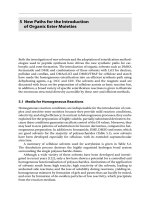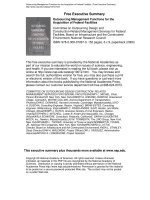the scientific explanation for the existence of vampires
Bạn đang xem bản rút gọn của tài liệu. Xem và tải ngay bản đầy đủ của tài liệu tại đây (35.91 KB, 4 trang )
Vampires have been seen and documented throughout history.
The history ofvampires goes further back in time than most people
realize. The chaldeans, who livednear the Euphrates river in the
southwestern part of Asia more than five hundred yearsbefore the time of
Christ , feared vampire or creatures similar to vampires enough so
thatthey created charms to protect themselves from being attacked by
such creatures. TheAssyrians and the Babylonians feared a creature
similar to a vampire known as anEkimmu. These creatures known as
Ekimmus were believed by the Assyrians to roam theplanet searching for
food although it was not always a persons blood but rather a
persons'vitality or that persons' energy force. It was believed that if such
a creature would entersomeone's house that person along with his or her
family would slowly weaken, get sickand probably die. In the countries of
Syria and Palestine references were made to suchblood sucking
monsters on ancient carved tablets. In Ireland the people believed in
thesecreatures, which they affectionately came to call "red blood suckers"
. Due to their beliefin these mythical creatures they began the practice of
placing stones on these vampiresgraves to kep them from escaping.This
then became standard practice and is still used tothis day in the form of a
tombstone. Tombstones were used to control ghosts and otherspirits
instead of their original use in controlling vampires.
Due to the fact that
vampires seemed to be so commonplace around the globe,there was a
large variety of vampires that differed in shape, behavior and method of
becoming a vampire. All of these factors varied from region to region. In
the country ofBulgaria a vampire had only one nostril. This Bulgarian
vampire would rise out of it'sgrave nine days after death in the form of a
shower of sparks and remained in this shapefor a period of forty days.
After the completion of these forty days the shower of sparkswould
regain it's human form. Once human-like the vampire goes from playing
childishtricks, which it did in it's "spark" form , to more serious matters ,
such as the attacking ofhumans and drinking of their blood. Vampires
are well known for their craving forblood but in many countries vampires
were not limited to just that substance as part oftheir diet, but would also
consume foods that humans ate such as eggs and rice. That,however,
does not mean that their yearn for blood was any weaker than before.
Mostvampires would attack their victims and suck the blood from
puncture wounds made inthe neck (The Russian vampire would suck the
blood directly from the victims heart).Sometimes the vampire would gorge
itself until it had drained the victim completelywhile other times it would
take just enough to satisfy that night's thirst and come back thefollowing
night and take a bit more. The method of drinking from the same victim
nightafter night would cause the victim to get weaker and weaker . Due to
the fact that thevictim was indeed attacked by a vampire, that would
mean that upon the victims deaththey too would become "undead." (.
Vampires p22) Certain cultures around the globe also had systems
to recognize vampires. Insome cultures vampires were distinguished due
to the color of their hair. In mostChristian countries vampires could be
recognized because they had red hair like JudasIscariot, the man who
betrayed Christ in the bible, was said to have had red hair. Eyecolor was
another tell-tale sign used to identify vampires. In Greece ,where most
peoplehave dark colored eyes, vampires were said to have blue eyes,
Rumania they were said tohave had gray eyes, and in Ireland they had
black eyes. Vampires have been around for centuries , in some cases
they have beenrecognized and feared by cultures that were around
thousands of years before the time ofChrist, such as the Babylonians and
the Assyrians. Throughout the ages many medicalexplanations that could
explain the vampire phenomena have been overlooked. The firstreason
was the lack of education that many people, because schooling was not
animportant part of these societies. Their lack of medical knowledge
about diseases, someof which are quite rare and hard to explain even to
this day was a large factor in thespread of vampire lore. Along with the
fact that very uneducated people have always hada tendency of being
overly superstitious also contributed to the vampire legend. In 1985Dr.
David Dolphin, Ph.D., a professor of chemistry at the University of British
Columbiapresented his theory that blood-drinking vampires were not
vampires at all but rathervictims of a disease known as
Porphyria.(Dresser, Norine. American Vampires p171) "Porphyria is an
incurable genetic disease which affects at least 50,000 patients in the
U.S.that causes sudden symptoms of severe pain , respiratory problems,
Skin lesions andsometimes death."(Dresser, Norine. American vampires
p171) "Porphyria may well havebeen responsible for many a vampire tale
- especially since the disease is hereditary"(Garden, Nancy. Vampires
p98) A person that is affected by Porphyria can seem veryscary to the
average person since the disease causes the persons gums to tighten.
Thatcauses their teeth to be seen much more prominently as well as
causing their teeth andnails to gain a fluorescent glow.These traits could
then go on to explain the fact thatmany vampire stories described the
vampires as giving off a greenish glow. Victims ofthis disease are likely to
be deformed in other ways as well but usually in the facial area.Because
of the skin lesions suffered by victims of Porphyria they are usually
verysensitive to light which would cause them to not venture out of their
homes until night.This aspect of the lifestyles of people suffering
Porphyria would fit in very well with vampire lore.
Garlic was used as a repellent of vampires butmore likely victims ofthe
disease known as Porphyria would have a strange chemical reaction with
garlic whichwould cause the person to have a severe porphyria attack.
This would then make thatperson very reluctant to come close to the
garlic since it contains large amounts ofDialkyl Disulfide which destroys
Heme in the persons blood ( Heme is the pigmentedcomponent of
Hemoglobin and related substances found in largest amounts in the
bonemarrow, red blood cells, and the liver ). The further destruction of
Heme in a Porphyriavictim would set off a severe allergic reaction. Since
Porphyria is also a genetic diseaseseveral siblings in a family usually
carry the defective gene. While the siblings may sharethe same defective
gene sometimes only one of the siblings will display any of thesymptoms .
It is known that in many vampire tales , vampires return to attack
theirsibling or other family members.This along with the fact that
Porphyria could betriggered in a person who is genetically predisposed to
have the disease by a sudden lossof large amounts of blood. When these
factor are taken into consideration, one could saythat when a vampire
came back to attack a sibling and when the sibling also began toshow
some vampire characteristics , it could be assumed that the Porphyria
gene in thesecond sibling could have been triggered by the loss of blood
which was suffered duringthe attack by the first sibling or the "vampire."
This would make it seem as though thevampire attack had caused the
second sibling to turn into a vampire as well. Plague was another factor
which could explain the growth of the vampire legend.In the Stephen King
book Salem's Lot which is the story of a town that is infested byVampires
and due to the infestation of vampires causes the town to become a
ghost town.In the book it says" But a little over a year ago something
began to happen in Jerusalem'sLot that was not unusual, people began
to drop out of sight." (King, Stephen. Salem's Lotp15) This phenomenon
which is found in Stephen King's book was not at all uncommonin ancient
times especially in remote places. Villagers in these remote places would
havebelieved that blood was a Vital substance that gave life. Since they
did not know muchabout disease their lack of knowledge of diseases and
their lack of medical practitionersin these remote areas would give the
perfect opportunity for their superstitious beliefs tocome into play. If
suddenly much of the town began to fall ill at the same time and theyall
displayed similar symptoms such as weight loss , weakness and paleness
they wouldthink that these people must have been drained of the vital
substance, blood. Searchingfor an explanation without any medical
knowledge the one thing that would make senseto them would be that a
vampire was on the loose while the fact that the town could be inthe
middle of an epidemic such as the black plague during the Dark Ages. In
StephenKing's book a town would just seem to disappear for no reason
and the only explanationwould be vampires. In the Dark ages the
situation would be very similar to that in theStephen King book except
that in Stephen King's book the vampires are real. Tuberculosis or
consumption as it was often called is a disease that although wasnot
highly contagious was a very common disease up until the mid-1800's .
Thebeginning stages of this disease do not contain very recognizable
symptoms.By the timethe symptoms showed up (such as weight loss and
fatigue which is where the nameconsumption came from) the disease
was already in it's later stages. Tuberculosis wouldhave been very difficult
to diagnose by people with no medical knowledge especiallywhen the
most serious symptoms of the disease such as coughing and spitting up
bloodwere not present. Tuberculosis was often openly confused with
vampirism as was thecase when in the mid- 1800's the corpses of many
victims of Tuberculosis were treated asvampires and buried face down or
by being dug up and burned when members of theirfamilies suddenly
came down with Tuberculosis.(Garden,Nancy. Vampires p69)
The mental aspect of vampires has always seemed to be that of
someone who wasnot in their right mind. In Anne Rice's book The
Vampire Lestat at one point one of thevampires in the book just looks at
the other one and simply says "You're the mad one." (Rice, Anne. The
Vampire Lestat p73) not realizing that madness plays a large parttowards
explaining the vampire legend as well as other mental conditions. One of
theseconditions which could explain the vampire legend is the condition
known as a catalepticcondition which many times is brought









